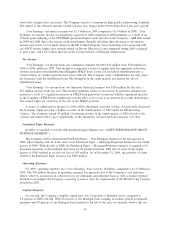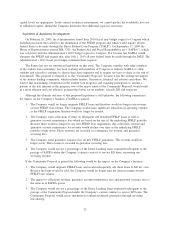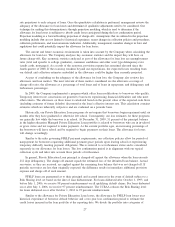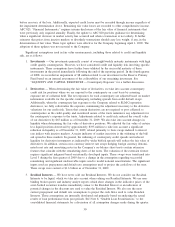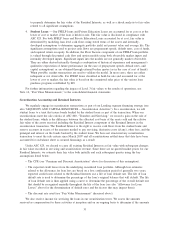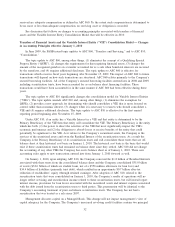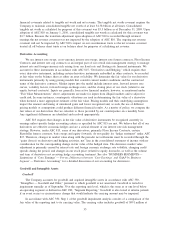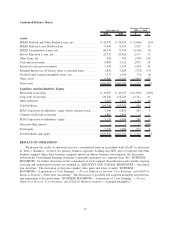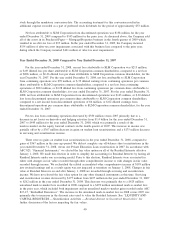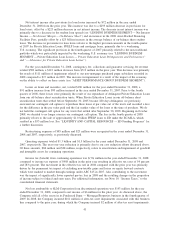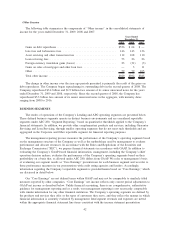Sallie Mae 2009 Annual Report Download - page 35
Download and view the complete annual report
Please find page 35 of the 2009 Sallie Mae annual report below. You can navigate through the pages in the report by either clicking on the pages listed below, or by using the keyword search tool below to find specific information within the annual report.December 31, 2009 and 2008. The Company retains an appraisal firm to perform annual Step 1 impairment
testing. Accordingly, the Company engages the appraisal firm to determine the fair value of each of its four
reporting units to which goodwill is allocated as of September 30. These four reporting units are Lending,
APG, Guarantor Servicing and Upromise. The fair value of each reporting unit is determined by weighting
different valuation approaches, as applicable, with the primary approach being the income approach.
The income approach measures the value of each reporting unit based on the present value of the
reporting unit’s future economic benefit determined based on discounted cash flows derived from the
Company’s projections for each reporting unit. These projections are generally five-year projections that reflect
the future strategic operating and financial performance of each respective reporting unit, including assump-
tions related to applicable cost savings and planned dispositions or wind down activities. If a component of a
reporting unit is winding down or is assumed to wind down, the projections extend through the anticipated
wind down period. In conjunction with the Company’s September 30, 2009 annual impairment assessment,
cash flow projections for the Lending, APG, and Guarantor Servicing reporting units were valued assuming
the proposed SAFRA legislation is passed. If the Community Proposal is passed, it would result in additional
cash flows for the Lending reporting unit but no material change in cash flows for the APG and Guarantor
Servicing reporting units. (SAFRA legislation and Community Proposal are discussed in more detail in
“OVERVIEW — Legislative and Regulatory Developments.)
Under the Company’s guidance, the appraisal firm develops both an asset rate of return and an equity rate
of return (or discount rate) for each reporting unit incorporating such factors as a risk free rate, a market rate
of return, a measure of volatility (Beta) and a company specific and capital markets risk premium, as
appropriate, to adjust for volatility and uncertainty in the economy and to capture specific risk related to the
respective reporting units. The Company considers whether an asset sale or an equity sale would be the most
likely sale structure for each reporting unit and values each reporting unit based on the more likely
hypothetical scenario. The Company has concluded that a hypothetical equity sale scenario would be more
likely for its Lending reporting unit, while a hypothetical asset sale would be more likely for the APG,
Guarantor Servicing and Upromise reporting units.
Discount rates employed in conjunction with the income approach reflect market based estimates of
capital costs and are adjusted for management’s assessment of a market participant’s view with respect to
execution, concentration and other risks associated with the projected cash flows of individual reporting units.
Accordingly, these discount rates are reflective of the long standing contractual relationships associated with
these cash flows as well as the wind down nature of the cash flows for certain components of the Lending and
APG reporting units and the Guarantor Servicing reporting unit as a whole. Management reviews and approves
these discount rates, including the factors incorporated to develop the discount rates for each reporting unit.
For the valuation of the Lending reporting unit, which assumes an equity sale, the discount rate is applied to
the reporting unit’s projected net cash flows and the residual or terminal value yielding the fair value of equity
for the reporting unit. For valuations assuming an asset sale, the discount rates applicable to the individual
reporting units are applied to the respective reporting units’ projected asset cash flows and residual or terminal
values, as applicable, yielding the fair value of the assets for the respective reporting units. The estimated
proceeds from the hypothetical asset sale are then used to pay off any liabilities of the reporting unit with the
remaining cash equaling the fair value of the reporting unit’s equity.
The guideline company or market approach as well as the publicly traded stock approach are also
considered for the Company’s reporting units, as applicable. The market approach generally measures the
value of a reporting unit as compared to recent sales or offerings of comparable companies. The secondary
market approach indicates value based on multiples calculated using the market value of minority interests in
publicly traded comparable companies or guideline companies. Whether analyzing comparable transactions or
the market value of minority interests in publicly traded or guideline companies, consideration is given to the
line of business and the operating performance of the comparable companies versus the reporting unit being
tested. Given current market conditions, the lack of recent sales or offerings in the market and the low
correlation between the operations of identified guideline companies to the Company’s reporting units, less
emphasis is placed on the market approach for the APG, Guarantor Servicing and Upromise reporting units.
34


